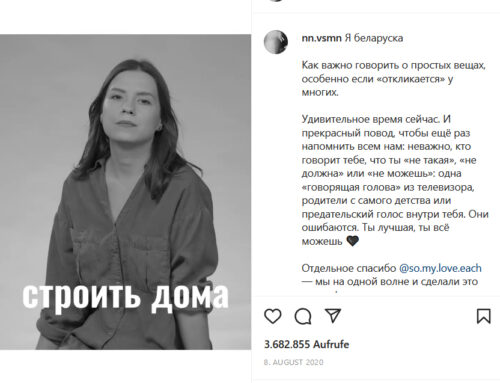Two of the most successful fundraising videos in recent memory illustrate several key strategies of professional production and distribution in the context of charity.
THE MOST SHOCKING SECOND A DAY VIDEO and its sequel STILL THE MOST SHOCKING SECOND A DAY are prime examples of non-governmental organisations (NGOs) employing new kinds of rhetorical and aesthetic strategies as well as making use of new modes of production and distribution in the Web 2.0 in order to reach the largest possible audience. Due to their tremendous online success, both videos have become highly popular and easily recognisable hallmarks of the children’s rights organisation “Save the Children”. This globe-spanning network of 30 NGOs actively promotes child protection, emergency relief, education, violence prevention and health measures in 120 countries, serves as an advisor to the UN and had, in 2014, two billion dollars of revenue at its disposal.
Both videos are centrally positioned on several of the network’s web pages. They were essential elements of two fundraising campaigns, “Save Syria’s Children” (2014) and “Save Child Refugees” (2016), both of which were also promoted on Facebook and Twitter and through various other means, including photo campaigns (#Facesforsyria) and through the collection of donations. The campaigns’ goal was to counteract the Western public’s emotional numbing towards the ongoing civil war in Syria, thereby boosting and reinvigorating the slowly but steadily dwindling willingness to donate. The MOST SHOCKING SECOND A DAY VIDEO served as the flagship for the first campaign and proved to be its most effective and important component. Within five days it had reached over 21 million views on YouTube and became the platform’s overall most popular promotional video in March. Several television channels, newspapers, magazines and blogs reported on its success, and the advertising industry as well as multiple media organisations bestowed multiple awards upon the video, including, among others, the Gold Cyber Lion, Adweek’s Ad of the Week award, the Ad Age Viral Chart and the Viral Video Award.
The video’s alternative title, IF LONDON WERE SYRIA, reflects its simple but impactful premise – in the fictional narrative, the Syrian civil war is relocated to the City of London where a nine-year-old girl is leading a normal, happy life. She celebrates her birthdays with her family, goes to a local school, likes playing with her friends and parents. In the background (quite literally), however, a political conflict slowly creeps up on her family’s everyday life. Upon escalation, chaos ensues: when a bomb hits the house, the family is forced to flee the confines of their home. On their journey, they experience increasingly traumatic hardships and perils. Ultimately, the father is separated from his wife and daughter, who manage to get themselves to safety by reaching a refugee camp. In the meantime, one year has passed: mirroring the beginning of the film, the mother asks her daughter to make a birthday wish – this time, however, the traumatized girl just blankly stares into space. The video ends with black lettering on a white background accompanied by the logo of the NGO: “Just because it isn’t happening here / doesn’t mean it isn’t happening / #savesyriaschildren”.
Two years later, the sequel STILL THE MOST SHOCKING SECOND A DAY continues the girl’s story – a new form of online seriality. Not even the refugee camp is safe anymore, as it is now being threatened by the military. The girl needs to flee the ensuing chaos once more with her mother, but they get separated at the docks, as the refugee boat only holds room for one more. After the boat eventually capsizes and sinks, the girl and a little boy are washed ashore. Together, they need to fend for themselves in a foreign country and are met with hatred and hostility. Finally, they are torn apart, and the girl celebrates another lonely birthday all by herself in a processing centre. This time, the final message states: “It’s happening here. / It’s happening now. / #savechildrefugees”.
The events depicted are based on the true stories of Syrian children recorded and retold by the NGO. Initially, the warzone was relocated to Europe due to budget constraints – then, however, this relocation became part of a calculated strategy aiming to evoke empathy from the viewers: the video was supposed to make its intended audience, the European middle class, empathise with the suffering of the Syrian people by transferring the horrors of civil war into familiar everyday surroundings. By employing this strategy of “universalising empathy”, the viewers do not need to embrace a different society and its culture, but merely imagine that they may one day find themselves in the portrayed situation in one way or another.
The title MOST SHOCKING SECOND A DAY VIDEO does not only intend to raise the viewer’s curiosity with a blatant superlative (a common technique commonly used in Clickbaiting), but primarily refers to the rather spectacular narrative structure of both videos: they intentionally imitate the “One Second a Day” genre, a format where the “produsers” – by using the App “1 Second everyday”, for example – record one second of their lives every day (inspired by Sam Cornwell’s “A Second a Day from Birth”, specifically). This principle of video compilation is then further combined with the centred, frontal perspective of the “One Photo A Day” genres – the users record themselves while looking directly at the camera. This achieves an extremely rapid pace of narration via time compression (an entire year in just about a minute) and creates an impression of authenticity as well as an empathetic connection with the protagonist: the frontal close-ups on the child’s face emphasise her expressions and emotions, the blurred background and temporal fragmentation (an effect achieved by relying on abrupt cuts throughout the video) make the girl’s subjective experiences tangible and give her feelings of despair and disorientation emotional impact. In addition, proven techniques of generating compassion are used: the individualisation of collective problems, an emphasis on people in dire need for help, and proximity (and ideally some sort of resemblance) to the target group.
The underlying structure of the film’s narrative corresponds to classical linear storytelling: the likeable protagonist must leave her normal, trusted world behind, the conflict she faces intensifies until it reaches its climax, after which her arch is then formally completed by cyclic framing which contrasts the film’s beginning with its ending. The pictorial and auditory aesthetics underline this development by darkening the overall atmosphere, an effect achieved by, among other things, an increase in visual and acoustic shocks (e.g. hard cuts, sudden noises and flashes of light) and a general desaturation of colour; both of which was implemented by companies specialised in post-production. From a rhetorical perspective, the little girl – looking directly at the camera, her eyes filled with despair and suffering – is a topical figure of representation, identification and pathos. It is through her presence and emotivity that the video succeeds in so compellingly outlining a simple but convincing argument for the support of emergency relief measures: Help those in need, for war and displacement could some day also befall you and your family.
The videos’ success and carefully handcrafted design are the result of a well-thought-out process of production and distribution – something that can by now be regarded as characteristic for the work of larger NGOs. They frequently outsource the production of their web videos to professional advertising agencies and film production companies – external parties that tend to be more familiar with successful methods of viral distribution. Specifically, Save the Children commissioned the agency Don’t Panic, which, in turn, sought out the help of the production companies Unit9 and Stink. Several of these companies’ members were also responsible for the success of campaigns launched by other organizations, including creative director Richard Beer who oversaw the production of Unicef’s A VACCINE FOR VIOLENCE, and director Martin Stirling who worked on Greenpeace’s LEGO: EVERYTHING IS NOT AWESOME video. The over sixty individual scenes used in the MOST SHOCKING SECOND A DAY VIDEO were shot in London by an experienced film crew in just under two days. Lily-Rose Aslandogdu, the actress who played the little girl, became famous after the video’s launch and subsequent success, appearing in two television series as well as the Hollywood film A MONSTER CALLS.
After the videos’ emotional impact quickly became apparent in several test screenings, their distribution followed a calculated plan. According to the companies’ own information, Don’t Panic generally coordinates its videos’ international distribution schedule via social networks, relies on various strategies such as paid promotion, tagging and seeding and does PR in order to gain media coverage. As celebrities often act as “multipliers”, as gatekeepers to entire audiences, their involvement was also crucial for the success of the MOST SHOCKING SECOND A DAY VIDEO: interest flared up significantly after film star Ashton Kutcher shared a press article about the video on his Facebook page on Nov 6th, 2014. According to Don’t Panic, the video has so far been shared more than 1.5 million times and contributed in a major way to the success of Save the Children’s YouTube presence, gaining their channel a large number of subscriptions. Both videos are grouped with five other short films about the Syria crisis, and the list of recommended videos directs the viewer towards several other of the NGO’s video productions. The change of perspective – “imagine if we ourselves were the refugees” – is a content strategy also employed in Amnesty International’s WHEN YOU DON’T EXIST, while the formal strategy of time compression can be found in Unicef’s #SYRIACRISIS: 5 YEARS IN 60 SECONDS.
The MOST SHOCKING SECOND A DAY VIDEO and its sequel are, in essence, fundraising and mobilisation videos, and as such culminate in direct calls to action. While the video is still running, call-to-action overlays (YouTube: “sponsored cards”) are displayed within the view frame – one of those panels asks British and American users to make a direct mobile donation by text message. Another panel – titled “How you can help” – links to the NGO’s website containing detailed information (such as the information brochure “Childhood under Siege”) and also inviting users to contribute money towards its cause. “Save the Children” has claimed its first campaign was a success, gathering about 340,000 dollars and thereby helping tens of thousands of people by supplying them with water, clothing, education, healthcare and trauma treatment.
These impressive results have nevertheless been answered with widespread criticism of the videos themselves, especially their alleged Eurocentrism, forced empathy and obtrusive brand building. Although these individual points of criticism may all be valid, it is questionable whether the videos could have reached this many people in online and mass media, could have become just as ingrained in participatory action and could have had a similar effect on their target group through other means. The countless comments left under the videos further demonstrate that both of them have gained importance in the context of the controversially debated refugee crisis and are often used as examples in order to reinforce a call for empathy, humanity and the willingness to help. Possibly more deserving of criticism than the videos are some of the charitable organisation’s other practices, however: for more than 40 years it withheld Ken Loach’s television documentary SAVE THE CHILDREN (aka THE SAVE THE CHILDREN FUND FILM, 1969) due to the critical views expressed in the film. And one of the organisation’s ambassadors is, rather ironically, Samantha Cameron, wife of the former British Prime Minister who himself was responsible for allowing only a small number of refugees into his country.
Jens Eder



